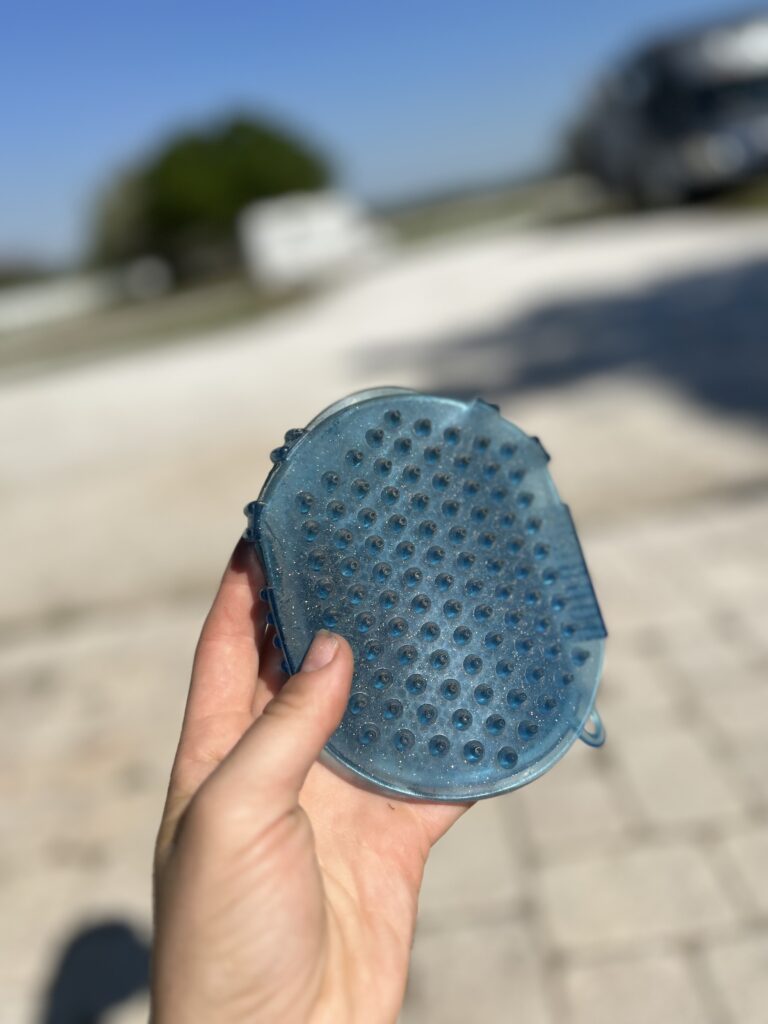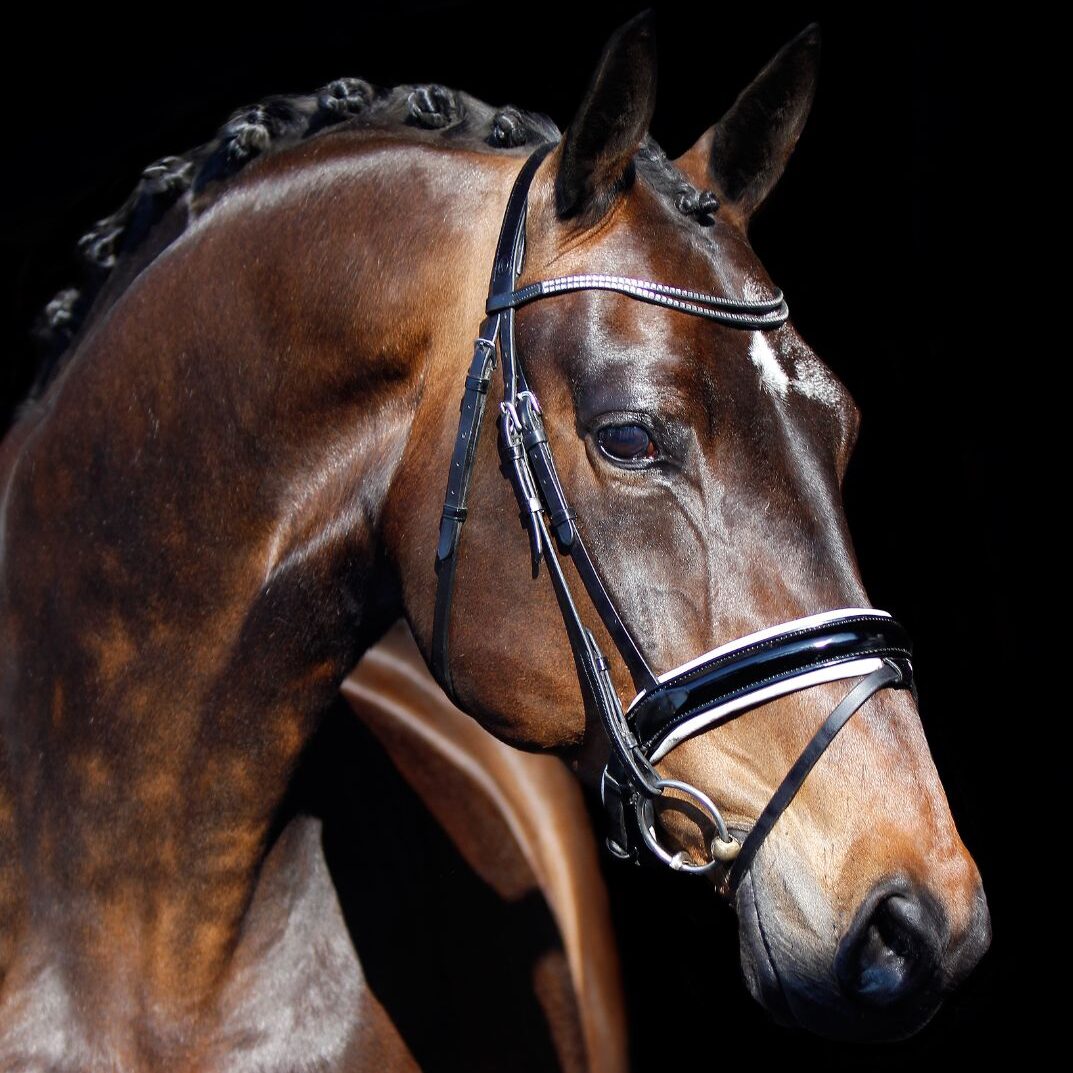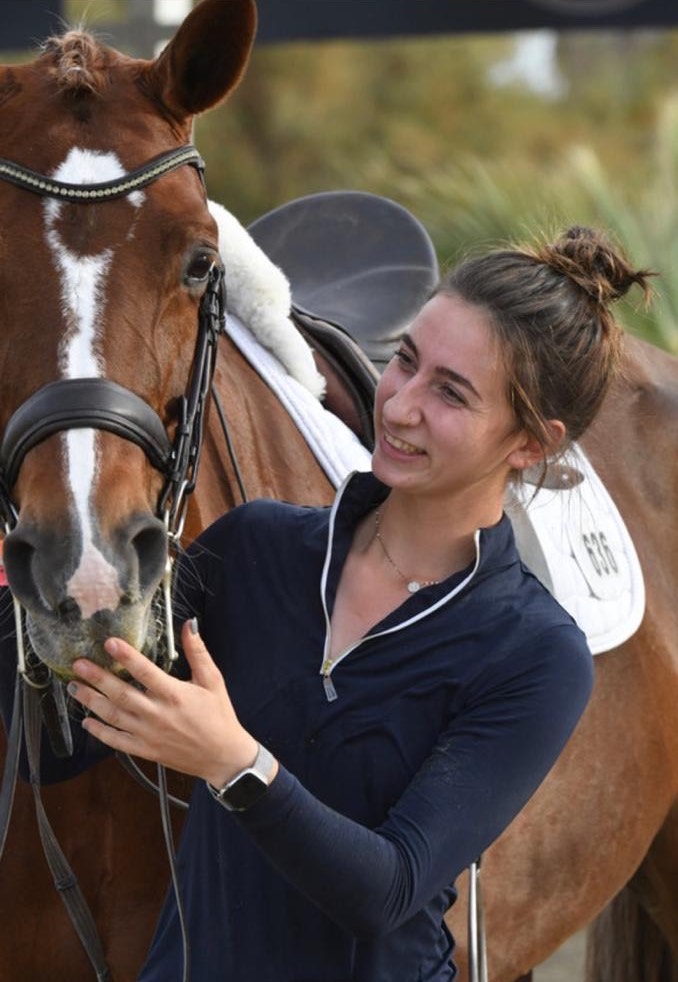When asked about my hobbies, I often joke that I only have two: grooming my horses and little organizational tasks. In my last post, we discussed an organizational task, so this time I’d like to talk about a particular passion of mine – grooming! Today, I’m going to break down each detail of my grooming routine and explain the how and the why. I will detail the materials used and each step that I use for each horse. Let’s get into it!
Let’s Talk Sebum
When managing a top sport horse, I consider two major organ systems for coat health and shine. Perhaps the obvious is the gut – a healthy gut will shine through in a beautifully dappled horse with a nice shiny coat, regardless of grooming. Of course, a healthy gut comes from many management areas folded together, and is not the purpose of this article.
The second major organ system that I consider is the skin. The skin is considered an organ, though it’s not pink and fleshy and is usually covered in hair. For a groom thinking of coat health, and knowing that the gut is adequately cared for, the skin is the most important organ. The skin must be cared for, looked after, maintained, and considered in every aspect of care when going about the day-to-day. Let’s quickly review the ‘parts’ of the skin relevant to our current topic:
- Epidermis – the tough, outer part of the skin that protects the inside from the outside.
- Sweat Glands – These are VERY important and pass through the epidermis and onto the hair follicles (which also pass through the epidermis). Horses are excellent sweaters, and this affects their skin.
- Sebaceous Glands – Remember this one! These glands produce oils that help keep the skin soft and stretchy, so the horse does not become dry and crackly. Furthermore, these oils provide a ‘waterproof’ quality.
My favorite of these structures is certainly the sebaceous gland. This gland produces sebum, that when cared for properly, takes your horse’s healthy gut shine to the next level, like a serious glow. Sebum is a natural oil that the right care can only enhance. Let’s talk about how.

Quality > Quantity
Personally, I try to avoid too many specialty products for my horses – I like to keep it simple. But, I believe that a few quality products are a must-have in your grooming kit when producing a top-tier shine and developing a healthy epidermis that protects the horse. Below are my top favorites:
- Metal Curry Comb – controversial, I know. But a must-have if used correctly.
- Medium Bristled Soft Brush – I prefer them to be a bit narrow, I don’t love the wide ones for everyday grooming. The bristles should be pretty soft, but short enough to hold their structure.
- Sparkle Jelly Curry – it has to be the two-sided one with the sparkles to be perfect. Those are just the softest and easiest on the delicate parts of the horse. Get two – you’ll use both by the end of this article.
- Hoof Pick – “duh”, you say. But, almost every new young groom I work with needs a crash course on proper hoof picking. Get a hoof pick that fits in your pocket, you’ll use it more. If it keeps falling out, get one of those little metal ones that have a loop at the end, and attach a double-ended snap to it, then hook it to your belt loop. You could even hop on a horse with it attached.
- Quality Rags – rags made for grooming are great but unnecessary. I like a good dish towel that’s been broken in and washed often. I also loop this through my belt loop so it’s always on my hip.
- Minimally used sprays and ointments:
- Detangler – Shapley’s detangler spray is great
- Fly spray – Something mild and NOT oil-based is my preference. I find the oil-based spray irritates more horses and causes the horses to get too oily and become dust magnets.
- Thrush – Cop-pur-cure or Therazure are my absolute favorites for soft soles or thrushy horses. I find many of the purple solutions too caustic.
- Shampoo – something mild, it doesn’t have to be fancy. The suave shampoo and conditioner works, or unscented ivory soap.



The Routine
I take a curry comb to my horses three times a day and this is vital to my horse’s coat health.
- Pre-Ride – you do as much or as little as you’d like as far as turn out for each ride, but make sure you take a curry comb over the entire body of the horse, and use a good brush to knock off all of the dirt, dander and dust that may have accumulated. My favorite curry for this is the soft jelly one. Also, I never fly spray between my first groom and tacking the horse – I don’t want any fly spray sitting under the saddle pad. Once the tack is on, flyspray may be used.
- Post-Ride – This is an incredibly important step. First, hose your sweaty horse as normal, getting them wet all over. Next, (and this is my favorite part) take your second jelly sparkle curry and curry the horse from top to bottom. It doesn’t have to be a big curry, but make sure you get the entire horse, including the belly, head, and legs. Pay special attention to the armpits and between the horse’s hind legs! These are the most commonly neglected areas of the horse when it comes to grooming. Go ahead and rinse the entire horse again, and continue rinsing until you see that water is beading off of the horse, and they will look as if they are waterproof. That is your sebum at work! This step cleanses the skin daily without needing to use shampoo, as too much shampoo strips the skin of its oils, but leaving any of that salty sweat on the skin will affect the health of the horse’s coat negatively. On Tuesdays, I bathe my horses in diluted shampoo and wash their manes and tails. I find that a weekly bath has greatly reduced the amount of dermatitis that my horses experience (especially in Florida!). Wash them too often and their skin will be stripped of its protective oils; too little, dirt and bacteria will build up on the skin and horses will start to have skin reactions.
- Afternoon Groom – This is the big one. I like to pull my horse back out of his stall when he is just about done with his day, and give him a big, all-encompassing and thorough groom. I’ve gotta swap back to bullet points for this one:
- Step One: Pick out all four feet, very thoroughly, and brush out the loose bits. Inspect for sprung shoes, heat, or thrush. Now is the time to treat thrush. I always make sure to really clean out the sides of the frog very, very well.
- Step Two: Metal Curry time. I like to use the metal curry from hocks up across the body, up the neck to the poll, and down to the knees. I rarely have a horse that does not tolerate the metal curry, and I am careful to avoid boney areas. I listen to my horses in terms of pressure with this curry. Many prefer that I am gentle over the barrel and shoulder, but really lean into their haunches.
- Why the metal curry? These curry combs are not so common in the United States, but once I started working for Catherine Haddad Staller, I learned that I really cannot live without them! The metal curry comb, when used properly, acts as a communication tool between groom and horse. I can massage my horses, and they can tell me where they are sore, or where they are undermuscled or underweight (because an undermuscled or weighted horse will not tolerate the metal curry). In return, I am moving the dirt to the surface of their coat and spreading their sebum around. This method brings out a true shine in the horse.
- Step Three: The sparkle curry. I use this on almost every inch of the horse: everywhere I metal curried, all down the distal limbs, up by the sheath, and across the face. Again, moving oils around and massaging the horse.
- Step Four: The Towel. Here, I like to take a towel with a dash of either Shapley’s no. 1 lite oil, or baby oil, and massage it in across the entire horse. I probably add oil about twice a week, unless the horse is incredibly dry (usually in the Fall).
- Step Five: Soft Brush. I take this body brush all over the horse, carefully brushing the face and entire body and legs, flicking dirt off as I go, and smoothing down the coat.
- As I groom, I am inspecting for sore points, heat, swelling, insect bites, or abnormalities in the tendons.
Whew! It may seem like my entire day revolves around currying my horses – and in a way, it does. I know that this routine is a huge contributor in not only the coat health of my horses, but in my relationship with them, as well. We communicate during these hours spent grooming, not just about their physical health, but mental as well. My horses and I have a conversation every day through the curry comb, and it shows in their beautiful healthy shine.
I began my grooming career at a young age. From the moment my childhood trainer suggested I’d become a professional groom, my destiny was set in stone.
To further my knowledge, I attended and graduated from Centenary University with a degree equine science in 2022. In the following years, I gained experience traveling and show grooming with top-ranked combined driving and dressage trainers, honing my FEI skills. Today, I am a professional groom for Jess Idol of Dynamic Dressage, of Winchester, Virginia, and Wellington, Florida.


